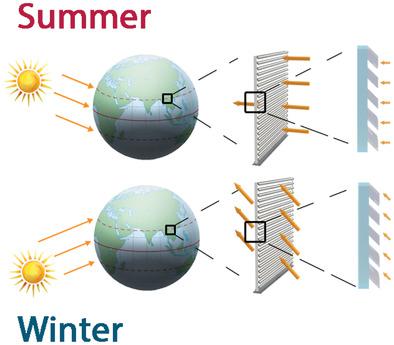当前位置:
X-MOL 学术
›
Adv. Opt. Mater.
›
论文详情
Our official English website, www.x-mol.net, welcomes your
feedback! (Note: you will need to create a separate account there.)
3D Printed Smart Windows for Adaptive Solar Modulations
Advanced Optical Materials ( IF 8.0 ) Pub Date : 2020-03-26 , DOI: 10.1002/adom.202000013 Chengzhi Zhou 1, 2, 3 , Dan Li 1 , Yutong Tan 4 , Yujie Ke 1 , Shancheng Wang 1 , Yang Zhou 1 , Guowei Liu 1 , Shaofan Wu 5 , Jinqing Peng 4 , Anran Li 6 , Shuzhou Li 1 , Siew Hua Chan 3 , Shlomo Magdassi 7 , Yi Long 1, 8, 9
Advanced Optical Materials ( IF 8.0 ) Pub Date : 2020-03-26 , DOI: 10.1002/adom.202000013 Chengzhi Zhou 1, 2, 3 , Dan Li 1 , Yutong Tan 4 , Yujie Ke 1 , Shancheng Wang 1 , Yang Zhou 1 , Guowei Liu 1 , Shaofan Wu 5 , Jinqing Peng 4 , Anran Li 6 , Shuzhou Li 1 , Siew Hua Chan 3 , Shlomo Magdassi 7 , Yi Long 1, 8, 9
Affiliation

|
Vanadium dioxide (VO2) based thermochromic smart window is considered as the most promising approach for economizing building energy consumption. However, the high phase transition temperature (τc), low luminous transmission (T lum), and solar modulation (ΔT sol) impose an invertible challenge for commercialization. Currently, smart window research surprisingly assumes that the sunlight radiates in one direction which is obviously not valid as most regions receive solar radiation at various angles in different seasons. For the first time, solar elevation angle is considered and 3D printing technology is employed to fabricate tilted microstructures for modulating solar transmission dynamically. To maximize energy‐saving performance, the architecture of the structures (tilt, thickness, spacing, and width) and tungsten (W) doped VO2 can be custom‐designed according to the solar elevation angle variation at the midday between seasons and tackle the issue of compromised T lum and ΔT sol with W‐doping. The energy consumption simulations in different cities prove the efficiency of such dynamic modulation. This first attempt to adaptively regulate the solar modulation by considering the solar elevation angle together with one of the best reported thermochromic properties (τc = 40 °C, T lum(average) = 40.8%, ΔT sol = 23.3%) may open a new era of real‐world‐scenario smart window research.
中文翻译:

用于自适应太阳能调制的3D打印智能Windows
基于二氧化钒(VO 2)的热致变色智能窗被认为是节省建筑能耗的最有前途的方法。然而,高的相变温度(τ Ç),低光透射率(Ť LUM),和太阳能调制(Δ Ť溶胶)对商业化提出了不可逆转的挑战。当前,智能窗户研究出人意料地假设太阳光沿一个方向辐射,这显然是无效的,因为大多数地区在不同季节以不同角度接收太阳辐射。首次考虑了太阳仰角,并采用3D打印技术制造倾斜的微结构,以动态地调节太阳的透射。为了最大程度地提高节能性能,可以根据季节之间正午的太阳仰角变化量来定制设计结构(倾斜,厚度,间距和宽度)和掺钨(W)的VO 2。T lum和ΔT sol受损的问题使用W掺杂。不同城市的能耗模拟证明了这种动态调制的效率。这第一次尝试以自适应地由具有最佳报告的热致变色性质中的一种(τ考虑太阳高度角一起调节太阳能调制Ç = 40°C,Ť LUM(平均) = 40.8%,Δ Ť溶胶= 23.3%)可以打开现实世界中的智能窗口研究新时代。
更新日期:2020-03-26
中文翻译:

用于自适应太阳能调制的3D打印智能Windows
基于二氧化钒(VO 2)的热致变色智能窗被认为是节省建筑能耗的最有前途的方法。然而,高的相变温度(τ Ç),低光透射率(Ť LUM),和太阳能调制(Δ Ť溶胶)对商业化提出了不可逆转的挑战。当前,智能窗户研究出人意料地假设太阳光沿一个方向辐射,这显然是无效的,因为大多数地区在不同季节以不同角度接收太阳辐射。首次考虑了太阳仰角,并采用3D打印技术制造倾斜的微结构,以动态地调节太阳的透射。为了最大程度地提高节能性能,可以根据季节之间正午的太阳仰角变化量来定制设计结构(倾斜,厚度,间距和宽度)和掺钨(W)的VO 2。T lum和ΔT sol受损的问题使用W掺杂。不同城市的能耗模拟证明了这种动态调制的效率。这第一次尝试以自适应地由具有最佳报告的热致变色性质中的一种(τ考虑太阳高度角一起调节太阳能调制Ç = 40°C,Ť LUM(平均) = 40.8%,Δ Ť溶胶= 23.3%)可以打开现实世界中的智能窗口研究新时代。











































 京公网安备 11010802027423号
京公网安备 11010802027423号